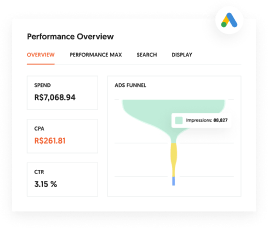
Do you know one of the most effective ways to grow your startup? It’s PR.
A strong, consistent PR campaign is the lifeblood of many successful businesses, and you know why? Because startup PR converts.
A PR strategy can further the customer journey and increase conversions. Additionally, as Kite Hill PR explains:
“If used with the right, targeted strategies, knowledge, and timing, releases can also lead to reputation-building media coverage which can put a brand on a short list. They can also help generate effective SEO that resonates months after an announcement.”
That’s not all.
When people talk about your startup positively, it gives you brand credibility, intrigues people, and makes them more likely to check out your company.
However, effective PR for startups doesn’t happen by chance. It’s no accident that the hottest startups right now are all over the media. That’s the power of PR machinery at work. All these brands have great services, but that’s not what gets them the coverage.
Behind every great brand story you see in the media is a sound startup public relations strategy, and with the right approach, you can turn your business into press-worthy news.
This advanced guide shows you how to use public relations for startups to increase your visibility and acquire more customers at a critical stage in your development.
With all that in mind, let’s look at how you can start telling your story to the media.
Mastering Your Story for the Media: 3 Essential Tips
A good story taps into our human experience and can move people and motivate action. Perhaps that’s why 88% of PR specialists say that digital storytelling is the future.
-.
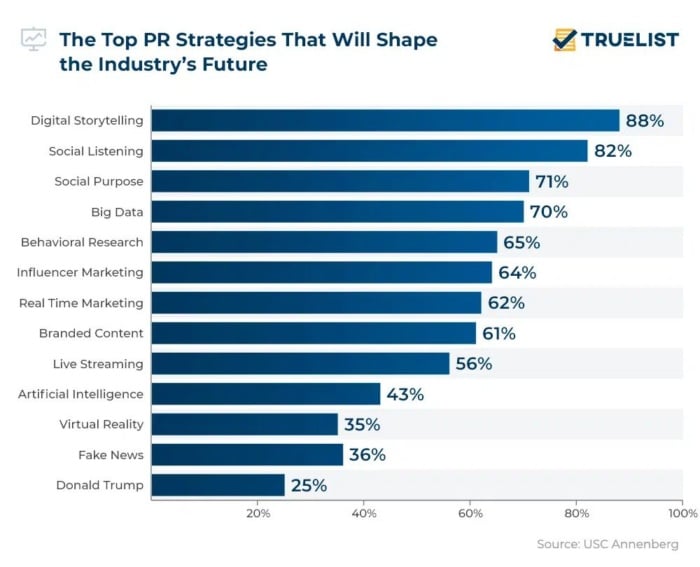
However, crafting a great story isn’t easy. As detailed below, there are several components you need to consider to make your startup story worthy of media attention.
1. Follow the 3 P’s of PR Storytelling: Product, Purpose, and Passion
You should build your media story on three basic elements: your product, purpose, and passion. Using this framework allows you to illuminate the high-level, “big picture” stuff about your startup:
- Product: Define exactly what your product or service is and/or what it does and where its niche offering fits into the existing industry landscape. To truly define your product, complete a competitive analysis very early if you haven’t already.
- Purpose: Identify your company’s “Why?” What purpose does it have? What problem does your product or service solve, and for whom? You exist because of your target customer, so you must understand who they are and what they care about.
- Passion: Use an enthusiastic, authentic tone that captures the passion, vision, and culture of your startup. You need to make your story and company human and relatable, so use real characters and events to shape your narrative. Honesty and vulnerability go a long way.
Once you have a deep understanding of the 3 P’s, then you’ve undergone a critical phase in startup development by articulating how your product or service aligns with the true needs of your market.
Take Buffer, the social media management app, as an example. Like many early-stage startups, Buffer founders Joel Gascoigne and Leo Widrich started their work in a basement. Buffer now generates millions upon millions in yearly revenue and has over 2 million users.
How did these founders begin telling their story?
First, Buffer sought to address the real pain point of their customers: people losing precious productivity time by posting manually on social media. When Buffer established a minimum viable product that met this need, it also started the BufferSocial blog to write content on social media topics that its target customers care about. After 10 months of blogging, it had 100,000 users.
By mastering the 3 P’s, developing a working product, knowing its customers’ pain points, and writing passionately for its audience, Buffer acquired thousands of customers while establishing itself as an authority on all things social.
2. Think Like a Journalist to Earn a Journalist’s Attention
Developing your 3P story lets you position your startup clearly and concisely. However, no matter how exciting you believe your 3P story to be, a journalist won’t find it interesting unless you give them a reason to. If you start thinking like a journalist, you’ll dramatically increase your chances for success.
That means making your story newsworthy.
As American Journalist Charles Anderson Dana once said:
“When a dog bites a man that is not news, but when a man bites a dog that is news.”
Here are some key elements of newsworthiness to keep in mind:
- Timeliness: News is “new” information. Think about ways you can contribute to cutting-edge discussions in your industry.
- Relevance: Keep a pulse on the most recent articles by journalists in your industry. Do an in-depth analysis of popular posts and see how you can tie them to your own story.
- Novelty: Consider how your particular angle or argument is unique. If you’re saying the same thing as everybody else, you’re not making a sturdy case for why they should feature you.
When you live and breathe your startup, it can be hard to acknowledge that your product might not be inherently interesting to someone else. Nevertheless, it’s absolutely essential to develop a strong filter for what’s newsworthy to get coverage.
Let’s use Renters Warehouse, a professional property management company, as a case study.
Real estate isn’t interesting to anyone who isn’t already making money from it. That leaves you with a problem. How do you connect with journalists who can get you in front of tens of thousands of potential real estate investors?
You tell the story of your inspiring young founder, Brenton Hayden, who retired at 27. The booming rental market (in a slow sellers’ market) was cutting edge. Gen Y success (and failure) stories were incredibly relevant at the time. Plus, what’s not novel about retiring at 27?
Brenton’s story quickly spread from Entrepreneur to Yahoo! Finance to Steve Harvey. The result? Over 82,000 page views in 24 hours to the Renters Warehouse website (which crashed due to traffic overload) and 576 solid leads in under two weeks. Not too bad—and all because his story showcased his 3 P’s, and he told it with journalists in mind.
3. Find the Right Angle: Tailor Your Story to Each Journalist
If you’ve developed a genuine story that is newsworthy, you’re halfway there. The next challenge is to figure out how to personalize that story to each journalist.
What ultimately “grabs” the journalist is highly subjective. That’s why it’s vital to establish your startup PR strategy, target journalists well in advance, and do the appropriate research to find the right angle.
Here’s an overview of how to nail down your targets and tailor your story:
Identify the Right Journalists: Pick three to five journalists and ensure they meet the following criteria:
- Relevant industry
- Topic
- Publication
This won’t leave you with a ton of options, but that’s the point: Research shows that 20% of your outreach will yield 80% of your results.
Tip: Go for smaller publications that cover your relevant niche. You’re much more likely to get traction if you focus on similar interests rather than getting the biggest media outlet. Place your bets on where your key audience is. That’s how you get the best engagement.
You can target journalists more closely by:
Researching your targets: By subscribing to your target journalists’ social feeds and publications, you can get a sense of their style, sense of humor, and what they’re passionate about. This helps you tailor your story to their interests and write to them in a more personal way.
Tip: You should also research your target journalists’ audiences. There should be an overlap with your own, but there are entirely new elements to consider. For example, journalists are loyal to their editors, publication, and readership, so your research should cover those bases.
Establishing your newsworthy hook: For your story to grab a journalist’s attention, you need to give them a reason to care. Use all the research at your disposal to create your hook.
Tip: Find a way to relate your story to topics that your target journalists have an interest in. Ask yourself: What issues do they cover often, and what are their most popular articles?
Cold calls and cookie-cutter emails annoy journalists and can easily land you on their block list. However, if you put in the work upfront to personalize your outreach, you’ll likely get something in return.
Building Relationships in the World of Startup PR
At the heart of any successful PR strategy lies the ability to create and build relationships. Follow these tips to maximize your outreach efforts and get journalists wanting to know more about your business.
Focus on ‘Human Relations’ for Long-Term Success
Targeting the right journalists is crucial to your success. However, if you’re not developing a relationship with these journalists, you’re just a stranger in the crowd. Imagine how much easier it would be to send your story to someone with whom you had already built rapport a year ago.
A good relationship can make all the difference to your startup’s PR efforts. However, the idea is not to go out and start pestering journalists with the hope that they’ll become “useful contacts.” Instead, take an approach that’s proactive in building community.
Follow the Golden Rule of PR: Make Friends Before You Need Them
Invest in relationships early on by giving something valuable before you ask for something in return.
If you’re wondering how to reach out to journalists and industry experts without feeling forced or self-serving, look at natural opportunities to chat about topics you both care about and where you can add value. You can do this by:
- Joining relevant groups
- Replying to publications and group forums
- Taking part in social media discussions
- Having a mutual friend introduce you
- Sharing interesting work on your networks
- Attending industry events
However, don’t post promotional content when you’re engaged in these discussions. Instead, focus on providing industry expertise and knowledge. Successful PR is altruistic because it focuses on creating mutually beneficial relationships.
You must put in an ongoing effort. It only pays off when you deserve it.
Connecting with a Journalist: 5 Key Tactics to Follow
Once you’ve begun building connections and providing valuable contributions to your industry, you can reach out to your target journalists.
The most important thing to keep in mind about your outreach is that it does boil down to your initial interaction, and there are some key tactics that can significantly improve your chances of getting traction:
Always seek permission before pitching: Don’t assume a journalist will automatically want to listen. You’re more likely to get a “yes” if you ask. Keep it short but personal:
Hey there,
Congratulations on the new gig with Business Insider.
A fellow PR friend mentioned you were a pleasure to work with at Forbes. I hope this new opportunity with BI is just as awesome.
I was wondering if it’s cool if I share a few details with you about a company in the HR/Small Biz space that may appeal to your Careers readers. Just in case they fit with anything you’re working on or perhaps spark an idea.
Thanks in advance. I look forward to hearing from you.
Hone in on what’s in it for them: Use a tailored and personalized approach that speaks to their professional interests and offers value:
- Work the headline: Follow basic copywriting 101. If you can get them to click on the headline, you may get them to read your first line of copy (and honestly, that’s the hardest part).
- Back everything with facts: Use relevant stats, case studies, and facts to show your organization’s impact. Have you helped a client find success? Say it and show it.
- Be prepared to support your pitch: Don’t wait until you get a “yes” to compile the supporting pieces that accompany your story. Otherwise, you risk keeping a journalist waiting. Have your media kit ready before you send your pitch.
- Follow up: No response from the journalist? That’s not unusual, as they’re busy people with tons of pitches coming at them. Leave it a week and follow up if you don’t hear back.
One of the most important things to remember is to treat a “no” like a future “yes.” When you get a no, take the opportunity to ask for feedback and suggestions. Never burn bridges, and always thank journalists for their time.
Example Pitch (once you’ve received permission):
Subject: << Include your irresistible headline here >>
Hey there,
I’m wondering if you might be interested in hearing more about a company that has developed a solution that << what problem are you fixing / why are you important >>
Company is <>, and they are << your positioning statement / who you are and what you do >>.
In short:
- << What makes you a game changer >>
- << Customers / Businesses Using You / Users to Date / etc. >>
- << Another important stat: money raised to date, notable board members/co-founders, etc. >>
Solid founder story << quick 1 or 2 lines on why they should care about where you came from and how you got to be a successful company today >>
I’d love to gauge your interest if you think there’s a compelling story here.
Going Beyond Media Relations: How to Evolve Your PR Strategy
Building media relations and getting the right press coverage is imperative for brand exposure since earned media from trusted journalists carries a lot of weight in the eyes of your potential buyers.
However, how you can “be in the media” has changed dramatically in recent years.
Today, it’s almost impossible not to take a blended PR approach to evolving your strategy.
What does that mean for your startup? It means using a combination of tactics to ensure your brand gets consistent coverage.
Here’s where to start:
Create Valuable and Consistent Content
Infuse your brand story into every piece of your content. It provides a unified, consistent voice across multiple digital platforms and improves your credibility. That’s why so many influential brands (think Red Bull) have become publishing powerhouses, creating social content, blogs, eBooks, infographics, events, and videos. They’re bringing the news to their customers.
Huge names like Gatorade, Etsy, Dove, and Microsoft also realize the benefits of branded content, such as building a relationship with your customers and engaging an audience. Additionally, millions more brands understand just how vital content marketing is.
One example of a brand excelling at this is Duolingo, which has an audience of 5 million plus on TikTok.
How does it achieve this? By putting in the groundwork first with A/B testing and social listening. It raises awareness on TikTok by creating content that resonates with its audience and draws viewers in.
Share Your Expertise on Non-Branded Outlets
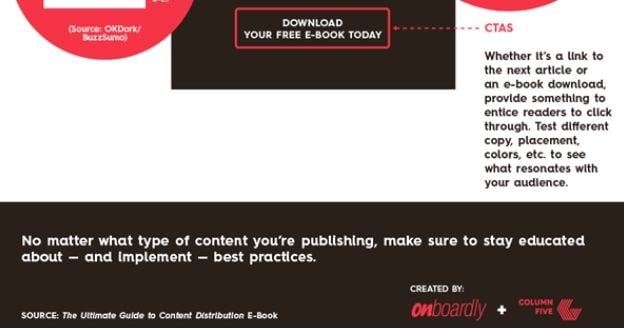
For example, Onboardly teamed up with Column Five to create an eBook and an accompanying infographic. As a result, many niche marketing publications published our content. An excellent way to build credibility is to contribute content on industry topics for media outlets or companies.
This might come in the form of a guest post or opinion piece on another company’s blog, or a partnership webinar or podcast. Sharing your expertise on non-branded outlets allows you to get third-party endorsements, build connections with thought leaders in your industry, and engage with your audience in new and exciting ways.
Leverage Your Social Outlets
Social media and social bookmarking allow you to attract and engage with niche communities in ways unheard of not long ago. In addition, you can use these social outlets as a mutually reinforcing tool for your PR efforts.
In addition to joining discussions on traditional social media outlets (Facebook, Twitter, LinkedIn, etc.), consider capitalizing on social bookmarking sites like GrowthHackers, Reddit, and Mix (formerly StumbleUpon). They offer a fantastic way for startups to stay plugged in, create discussions, and amplify the reach of PR placements.
Engaging regularly is essential because most of the content from major publications gets picked up organically. So focus only on relevant outlets and really dive into those communities.
Use PR Metrics to Measure and Improve
Want to maximize your startup PR efforts? Then you’ve got to stop relying on gut instincts and start using metrics to measure and improve your results.
One of the primary benefits of using PR metrics is that it helps identify what works and what doesn’t. By analyzing data such as media coverage, social media engagement, and website traffic, you can gain valuable insights into which aspects of your campaign resonate with your target audience.
Evaluating PR metrics also helps you:
- Understand your return on investment (ROI)
- Measure the effectiveness of different platforms/methods
- Position your brand to meet your customers’ expectations
Here are some of the PR metrics you should measure:
- Mentions: By monitoring the number and quality of press mentions your brand receives in different publications, you can gauge how well your message resonates with target audiences. This also lets you track which messages or campaigns generate the most positive coverage, providing valuable insight for future marketing strategies.
- Web traffic: A spike in website visits following a particular event or campaign can indicate that potential customers are engaging with your campaigns.
- Engagement: This refers to how much users interact with your content across various platforms, such as social media or websites. Measuring engagement helps you determine if your audience is interested in your messaging and whether they are taking action based on what they see or read.
- Impressions: This metric measures how many times people view your content. By tracking impressions, you can determine how successful your outreach efforts are in gaining coverage for your organization or client. For example, if a brand’s share of media on Instagram is significantly higher than its competitors, it may indicate that Instagram is an effective platform for reaching its target audience. You can then use this information to allocate more resources toward creating Instagram content.
- Sentiment: Understanding consumer sentiment is more important than ever in today’s fast-paced digital world, which bombards customers with tons of advertising messages daily. By monitoring consumer sentiment, brands can tailor their startup PR and communication strategies to resonate better with their target audience. Measuring sentiment also provides insights into consumers’ negative opinions of your brand, allowing you to address issues.
- Earned backlinks: These are links from other websites that point to your site and are crucial for improving your SEO ranking. When other reputable sites link to yours and mention your brand, it shows search engines that your startup has credibility.
Enhance Your Process and Analysis With PR Tools and Services
Undoubtedly, the way we consume news has changed dramatically over the past few years. These days, a strong brand strategy isn’t enough on its own. Instead, businesses need an always-present approach to capture and keep consumers’ attention.
How do you keep a constant presence and remain top of mind for your customers, though? Through proper planning. This way, you can ensure that there’s always a piece of startup PR out there.
To get started, just follow the steps below:
- Step 1. Brainstorm ideas: Create a mind map of ideas for the most newsworthy elements of your product or service. Get input from every single member of your team—this is not a “marketing only” exercise. Each department should have valuable insight into how to address your customers’ needs.
- Step 2. Establish emerging themes: Consider emerging themes from your brainstorming session and articulate how and why they engage your target audience. Again, apply your journalistic lens: What makes a journalist want to bite?
- Step 3. Map themes onto your calendar: Map out your themes onto a 12-month calendar. Consider one campaign every four to six weeks.
- Step 4. Develop relevant campaigns: Consider how content and social outreach can aid your PR outreach. Ask yourself what content suits each campaign. Then create content accordingly.
- Step 5. Invest in relationships: Get to know your target journalists well before your pitch. With advanced planning, you can get into a process where you’re one cycle or campaign ahead of your outreach.
- Step 6. Track your outreach: Log each correspondence you have with the media. Use tools like Hubspot’s Sales Hub or other email tracking software to understand if and when journalists open your email.
- Step 7. Gear up for sprints: Your team should be fully aware of campaign cycles and ready to participate, share, and engage with customers during these “sprint” periods. The more activity you can leverage during these periods, the better exposure you’ll have with customers.
- Step 8. Plan for downtime: Don’t ignore the in-between times to publish great content. Think about white papers, eBooks, guest blogging, partnered webinars, or podcast discussions. Aim for the content likely to have the greatest impact, and remember that less is more. Consider partnering with brands boasting larger networks to create joint content and keep it consistent with your overarching PR themes.
- Step 9. Test and reassess: Analyze the value of each media placement. Were there any problems that your team needed to resolve? Build in monthly, department-wide meetings to track your progress. Learn from any mistakes and refocus your energy to ensure you’re maximizing your startup PR efforts.
Everyone on your team should know what’s happening in your campaign cycle—from development to sales and marketing to admin. So keep lines of communication open at all times and update campaigns accordingly.
Now you know how to identify PR opportunities and target journalists effectively, here’s a list of tools to make your job much easier:
Cision
Are you in the market for high-powered PR software that drives serious results? Then look no further than Cision. The media research service tracks over 7 million websites and maintains a database of approximately 1.4 million journalists, editors, and influencers.
With Cision, you can communicate with the journalists and influencers in their database and connect with your audience.
When you know who’s mentioning your brand, you can turn this into relationships that benefit your company in the long run.
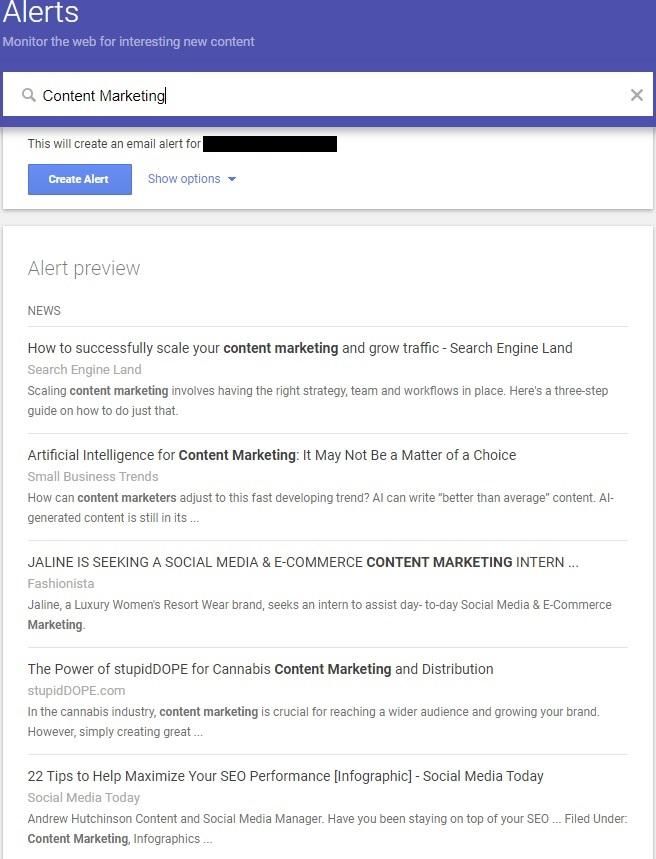
That’s not all Cision has to offer. Other features include:
- Advanced distribution of your press releases
- Tools for tracking performance
- Tools for tracking mentions
Additionally, Cision has tools for monitoring all of the following:
- Social media
- Broadcast and video
- Print media
- Online media
- Podcasts
- Daily news briefings
Cision also offers competitor analysis, interactive reports, and tracking data.

Cision provides custom pricing depending on the products you use and what you want to achieve.
PRWeb
What better way to get PR for your startup than by sending out a press release?
There are two keys to success with this approach:
- Creating a unique angle that journalists and bloggers will find interesting
- Using a service that distributes your release to a large number of media contacts
You are responsible for creating a unique angle by focusing on a topic that gives others a reason to cover your story.
From there, you can rely on PRWeb to push your release to the search engine masses as your own in-house PR firm. The way it works is simple:
- Create your news release.
- Distribute your news.
- Track your news.

With such a simple approach, getting started with PRWeb is easy.
PRWeb’s “measure the performance” feature is also worth checking out.
With this, you can answer questions such as:
- What is the digital footprint of my content?
- How much traffic did my press release generate?
- Where is my message resonating most?
- How much click-through traffic and social media shares did my content achieve?
- Which media outlets have received the release?

Also, PRWeb gives you keyword and search engine data to see how your audience discovered you.
Finally, there are a variety of add-ons to give your release even more punch.
The only downside of PRWeb is its pricing. The basic package starts at $105, with the premium package at $435.
Respona
Respona is a cutting-edge PR tool that uses artificial intelligence (AI) to analyze content influencers create in your field and help you personalize your PR pitches accordingly.
Respona offers four main features: link building, digital PR, blogger outreach, and content promotion.
Each feature comprises multiple components. For example, Respona can find your targets’ most recent email addresses for link building and blogger outreach using General Data Protection Regulation (GDPR)-compliant sources for link building and blogger outreach.
For blogger outreach, Respona personalizes your pitch by adding details gathered from the social media channels belonging to your targets.
To get the most out of Respona, integrate it with your other tools like Ahrefs, Semrush, and Moz.
Reponsa has a seven-day free trial, and pricing plans start at $99 monthly.
Business Wire
With Business Wire, you can take advantage of modern PR and digital content features while accessing the company’s network.
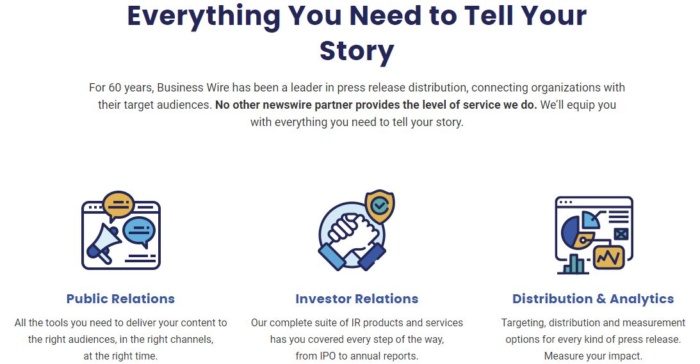
Some key features include:
- Press release distribution: Distribute PR releases to their news network, newsrooms, and influencers in the industry; web formatting; adding links to social media
- Smart News Release: Create shareable optimized photos and videos that will eventually appear on other sites
- Event services: Promote your trade shows/conferences
- NewsTrak Reports: Show your ROI analysis on coverage
- Social analytics: Track social media conversations resulting from your press releases.
- Media database: The most comprehensive media database worldwide and the ability to reach all commercial newswire services.
Press release pricing varies, and subscription packages are available.
Help A Reporter Out (HARO)
Wouldn’t it be great if you could provide journalists with expert insight regarding your industry? Well, you can with HARO.

Once you sign up as a source, you’ll receive three emails per day with the free package, with opportunities that may match your knowledge and experience.
Here’s an example of what an email from HARO looks like:
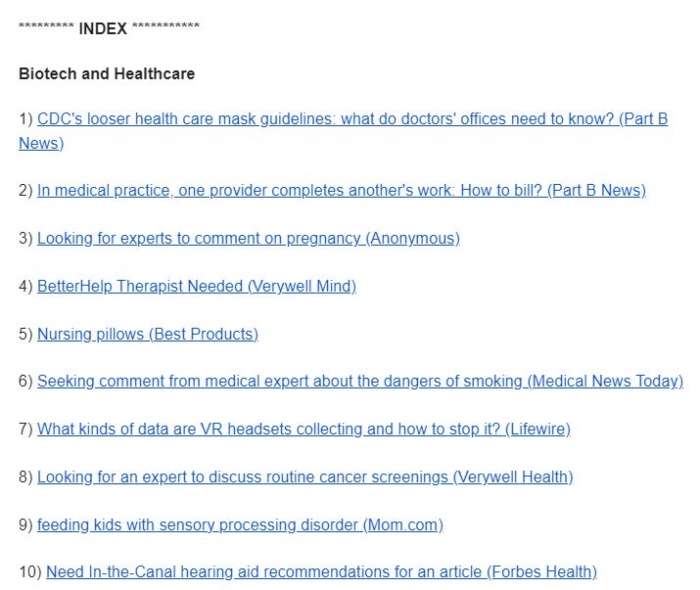
If you see something on the list that matches your expertise, just click through and follow the directions. If a journalist likes what you say, you can connect with them and provide them with expert insights.
The benefit of this media relation strategy is that your name and company get mentioned in the article created by your contact. Even better, there’s a good chance that the article links back to your website and boosts your search engine optimization.
Pro tip: With nearly 800,000 members, you need to perfect your pitch to increase your chance of receiving a response from the journalist.
A basic subscription is free. Paid subscriptions range from $19 to $149.
Muck Rack
What process do you have in place for finding and contacting journalists?
Like many startups, you may give little thought to this. Instead, you simply send out emails and hope for the best. While this may turn up occasional opportunities, it’s hit or miss.
With Muck Rack, you can take all the guesswork out of the process. As a result, this tool is one of the best for finding journalists and getting in touch with those that may be interested in your business.
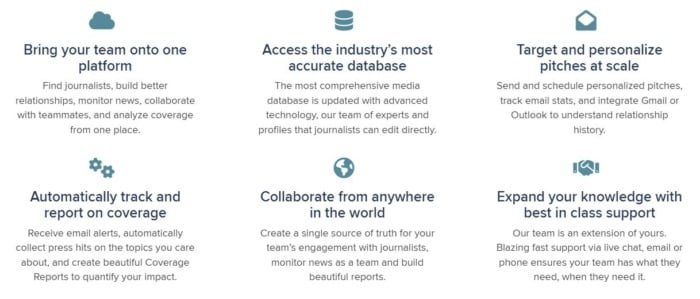
Here are a few of the many things that you can expect:
- The ability to find the right journalist(s) by searching company names, keywords, media types, and more
- Email notifications when somebody links to an article or publishes a tweet matching your search term
- The use of analysis tools to see who is sharing your content on social media
Pricing is available on request.
Meltwater
As one of the more advanced tools on this list, don’t be surprised if you spend hours getting familiar with Meltwater and its many features.
It’s a media relation hub for any small business keeping track of search engine buzz and social network trending data.
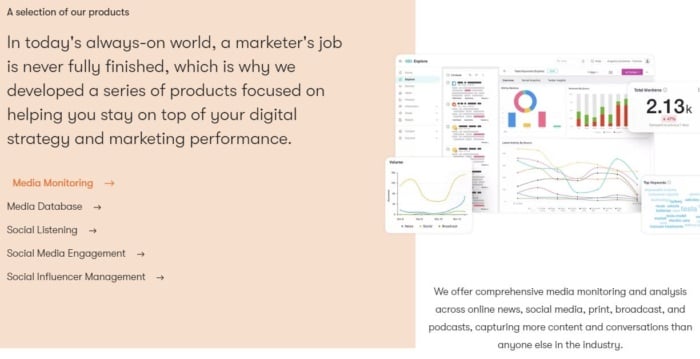
From a PR perspective, you’ll want to pay close attention to its Media Monitoring tools. With the ability to remain current with “500 million pieces of new content every day,” it’s easy to join the conversation when it makes the most sense.
You can also use these tools to pinpoint journalists who cover your industry. From there, you’ll have a better idea of whom to reach out to in the future and develop social media relations to help your small business grow.
Custom pricing plans are available.
CoverageBook
What is your approach to creating PR reports? If you don’t have a firm strategy, you might want to give CoverageBook a glance.
With CoverageBook, PR reporting is no longer a time-consuming and complex process. Instead, you can create high-quality reports within a matter of minutes. In addition, you can use the reports in many ways, such as sharing them with your team and providing potential clients with more information regarding your company.

Some of the top features of Coverage Book include:
- Automated screenshots of all coverage
- Ability to customize the appearance of every book that you create
- Paste coverage links, and CoverageBook collates them
- Automated metrics, including data from Moz and SimilarWeb, among others
- Measure metrics from online articles and social media
- Opportunity to store all of your news coverage in one place
On the surface, CoverageBook doesn’t appear to offer much in terms of getting a press release or media coverage for your startup. However, once you learn more, you’ll find that the data you collect gives you a better idea of how to generate more results in the future without the need for an expensive PR firm.
Pro tip: Review your coverage regularly, paying close attention to the types of journalists and sources most interested in your startup. You can then use this data to perfect future pitches.
Monthly plans cost $99.
Anewstip
How do you go about finding relevant media relations contacts?
Even with the help of the internet, it can take a lot of work to create a list of media contacts relevant to your industry.
Fortunately, a tool like Anewstip can provide the speed and efficiency you require.
This tool lets you quickly search for journalists and bloggers based on what they’ve published or tweeted. The site “helps entrepreneurs, PR professionals, and marketers connect with relevant media influentials.” So you’ll always have access to the best information.
Best yet, this is one of the most straightforward public relations tools you’ll ever come across.
Getting started means plugging your brand, competitor, or keyword into the search box.
You can break the data down to another level, searching by:
- Tweets
- News articles
- Journalist profiles
- Outlet profile
Here’s an example of a news article search for the keyword phrase “content marketing.” Finding top search engine experts in your industry is the start of developing long-term media relations channels.
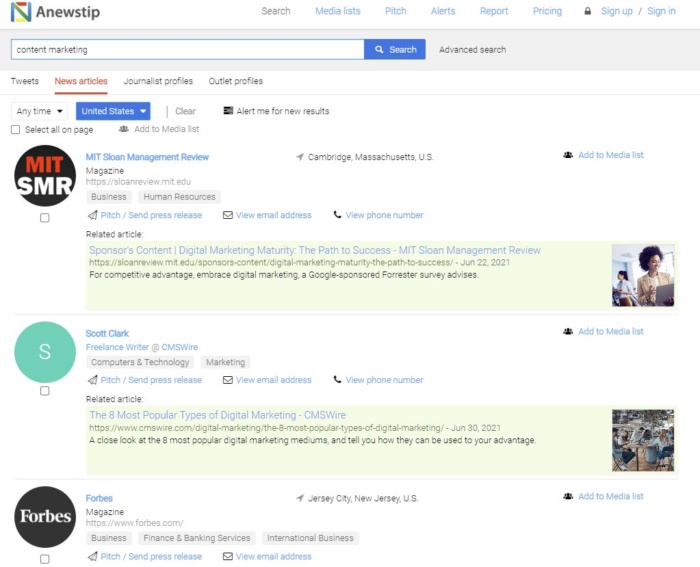
With the search results in front of you, it’s time to take action. If you find a journalist that you want to contact, click on Pitch / Send Press Release or View Email Address.
Other features include:
- Media outreach powered by AI
- News alerts
- Ability to create media lists
- Use of FinalScout to find LinkedIn users’ contact info
Pro tip: Take advantage of advanced search features, such as the ability to sort by date, time, language, and country.
There’s a free plan with limited functionality available. Paid packages start at $200 monthly.
Google Alerts
There are a lot of free tools out there that can help your new small business generate more publicity.
Google Alerts deserves your attention as it seamlessly delivers top-notch results.
Google defines this tool as follows:
“You can get emails when new results for a topic show up in Google Search. For example, you can get info about news, products, or mentions of your name.”
When it comes to PR for your site, there are a few types of alerts that you want to set up, including alerts for your:
- Company name
- Primary competitors
- Top keywords
For example, you can set up an alert for a product or service that is similar to yours. This way, you’ll receive an email notification every time it is mentioned. From there, you can review the article and determine if you can receive the same type of coverage for your startup.
From the Google Alerts page, you can type in any keyword imaginable. Doing so will show a preview that looks like this:
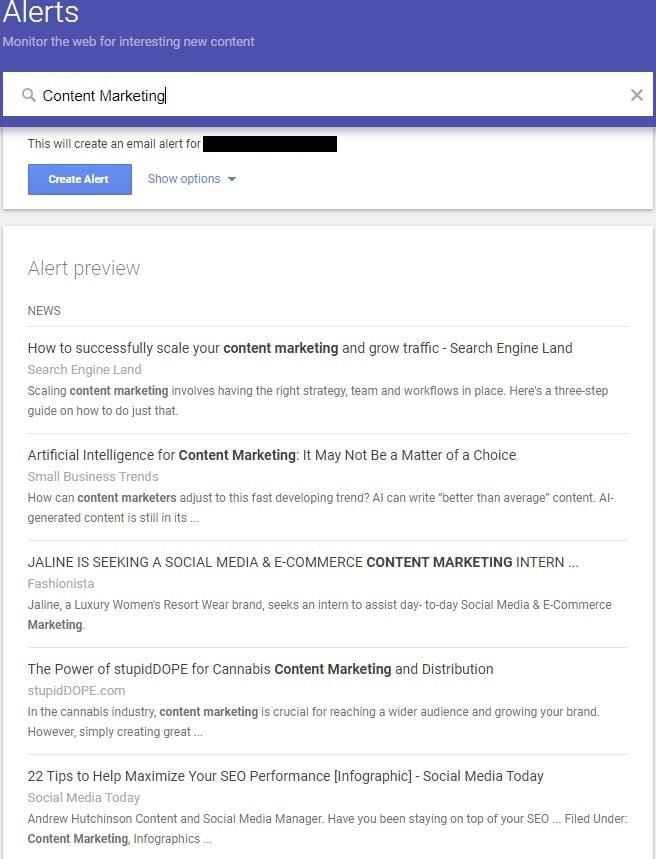
If you like what you see in the preview list, click Create Alert and wait for the results to pour in.
Pro tip: Don’t bog yourself down with too many Google Alerts. Instead, stick with those that are most important to your small business.
Mention
Who’s talking about your brand? Who’s talking about your name? Who’s talking about your competitors? Mention is a media monitoring tool that answers these questions.

Use Mention to:
- Never miss a conversation that mentions your company or name
- Identify influencers important to your company and industry
- Immediately jump into social conversations that mention your company, name, or competitors
In addition, Mention lets you track and analyze your performance.
You can track mentions by source type, time, location, language, etc. There’s also a breakdown of your most influential sources.
Pricing is from $41 a month.
Maintaining an ‘Always-on’ Presence: How to Map Out Your PR Calendar
It’s the aim of every startup, isn’t it? Being at the forefront of customers’ minds and increasing visibility.
If that sounds impossible, it doesn’t have to be. All you need is an always-on media presence or a content-packed calendar to keep your startup PR consistent throughout the year.
Use these tips to work toward an effective, always-on approach to your startup PR:
- Timeliness is the key to PR success. Start by identifying key dates, such as holidays or industry events relevant to your business. This helps you plan campaigns around these dates for maximum impact.
- Decide on your content type. You’ve got the best chance of engaging an audience if you use a wide range of content types, including blogs, press releases, social media, and videos.
- Keep up with trends, anniversaries, and international or national days.
- Brainstorm ideas with your team to fill out your calendar.
- Decide on the frequency of your PR activities. A weekly or monthly cadence keeps things consistent and helps build momentum for future campaigns. Also, consider the length of each campaign. For instance, shorter bursts may be more effective than longer ones.
- Leave some room for flexibility. While a strategy is important, you need some flex for new developments, news events, etc.
- Mix it up! Yes, I’ve talked a lot about press releases, but they’re just one part of a startup PR strategy. There are numerous other ways you can get PR, like reaching out to influencers, attending industry events, and supporting local projects.
- Track your results. What’s working for you, and what isn’t? You don’t know unless you’re analyzing your results. Meet regularly with your team to ensure everyone is up to date.
To get a head start, CoSchedule has a public relations calendar template to guide you.
PR is a Critical Component to Your Demand Marketing Mix
It’s not uncommon for startups to place their emphasis on product development rather than on customer development.
However, you must use startup PR in the early stages for a growth model that puts the customer first. This can help you discover your customers, continually refine your positioning, give much-needed exposure, and inform the building of the product itself.
FAQs
In today’s digital age, a solid public relations strategy is essential for any startup looking to make an impact in its industry. Public relations can help startups build brand awareness, credibility, and trust among their target audience. It can also give them a competitive edge by helping them stand out in a crowded market.
Focus on building relationships with journalists who cover your niche.
Additionally, contacting local newspapers and trade journals, writing guest posts, and issuing press releases are all proven methods of building PR.
You could also consider teaming up with influencers in your niche or approach local radio stations that feature/interview local business owners on their shows.
Finally, if you have a charity close to your heart, perhaps hold a fundraising event and invite local media for coverage.
PR helps to build your profile and improves your visibility.
By securing media coverage in publications or websites targeting your audience, you can attract more attention to your business and generate buzz around your offer. This increased exposure can generate new leads and customers and higher conversion rates for existing ones.
Secondly, good PR can also help build credibility and trust with investors and consumers. Positive media coverage or endorsements from industry influencers show that others recognize the value of your product or service.
Conclusion
Startup PR is essential to your startup demand marketing mix, but it’s only beneficial if you take a proactive approach.
PR sites like the ones featured in this article are simple, effective ways of marketing your business to get visibility and encourage consumers to check out your business.
You can use press releases to share company news, announce new product launches, and detail future plans.
Finally, you can use the boilerplate (a brief section at the end of a press release providing background information about your organization) in press releases, along with quotes, to shape your audience’s impression of your brand and highlight its values.
However, remember that without a solid digital and content marketing plan, your PR releases are useless. If you need help creating your strategy, let us know.
How do you get PR for your startup, and which PR tips for startups have worked well for you?
About the Author: Renee Warren is co-founder of Onboardly, a demand marketing agency that works with funded tech startups to gain greater visibility and acquire more customers. We work at the intersection where public relations, content marketing, and social media meet, to deliver marketing that gets results. Follow her on Twitter @renee_warren.

See How My Agency Can Drive More Traffic to Your Website
- SEO - unlock more SEO traffic. See real results.
- Content Marketing - our team creates epic content that will get shared, get links, and attract traffic.
- Paid Media - effective paid strategies with clear ROI.
Are You Using Google Ads? Try Our FREE Ads Grader!
Stop wasting money and unlock the hidden potential of your advertising.
- Discover the power of intentional advertising.
- Reach your ideal target audience.
- Maximize ad spend efficiency.

